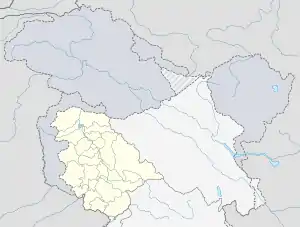Purmandal
Purmandal (also called Chhota Kashi)[2] is a village located on the Devika River in Samba district, Jammu and Kashmir, India. The village and its temples are a pilgrimage site for Hindus, who believe bathing in the river cleanses the soul.[3]
Purmandal | |
|---|---|
Village | |
 Purmandal  Purmandal | |
| Coordinates: 32.6958°N 75.0586°E | |
| Country | India |
| Union Territory | Jammu and Kashmir |
| District | Samba |
| Population (2011)[1] | |
| • Total | 1,276 |
Geography

Purmandal is located on the banks of the Devika River in the hills about 30 kilometres (19 mi) southeast of Jammu and about 25 kilometres (16 mi) northwest of Samba by road via Vijaypur.[2]
Around
Devika runs down from Purmandal to Uttarvehni through village Mandal. Uttarvehni in local dialect means flowing towards north. It is one of the rare places where a river flows from south to north. Rameshwaram and Bhuteshawar are ancient temples in Mandal.
Points of interest
Purmandal Temple, dedicated to Parvati, is built on the west bank of the river. A number of other temples are dedicated to Shiva. There is a large haveli (mansion) dating from about 1830, in good condition, and several dharamshalas (rest-houses for pilgrims), mostly severely deteriorated. Many of these structures are decorated with murals dating from between 1813 and 1898.[2][4]
Transport
Buses connect the village to Jammu.[2]
Events

Every month a Mela is organized here. The devotees take a holy dip in the Devak river and seek blessings. There are total 12 Mela in a year. Every Mela has assigned a unique name corresponding to the month, i.e. Chaitra Chaudish, Shivraatri Mela, etc.
References
- "Search Details: Purmandal". Census of India. Retrieved 11 July 2015.
- "Purmandal". Department of Tourism, Jammu and Kashmir. Retrieved 11 July 2015.
- Sarna, Jasbir Singh (2014). The Sikh Shrines in Jammu and Kashmir (Second English ed.). Bemina, Srinigar: Sant & Singh Publishers. p. 50. ISBN 978-81-86741-30-6.
- Charak, Sukh Dev Singh; Billawaria, Anita K. (1998). Pahari Styles of Indian Murals. Abhinav Publications. pp. 86–89. ISBN 978-81-7017-356-4.
